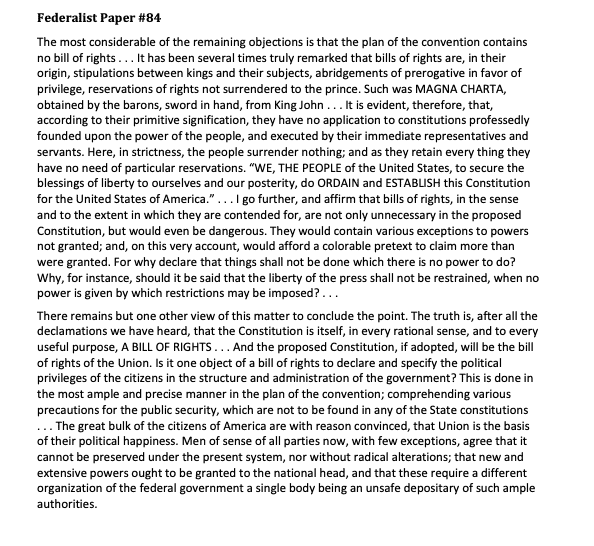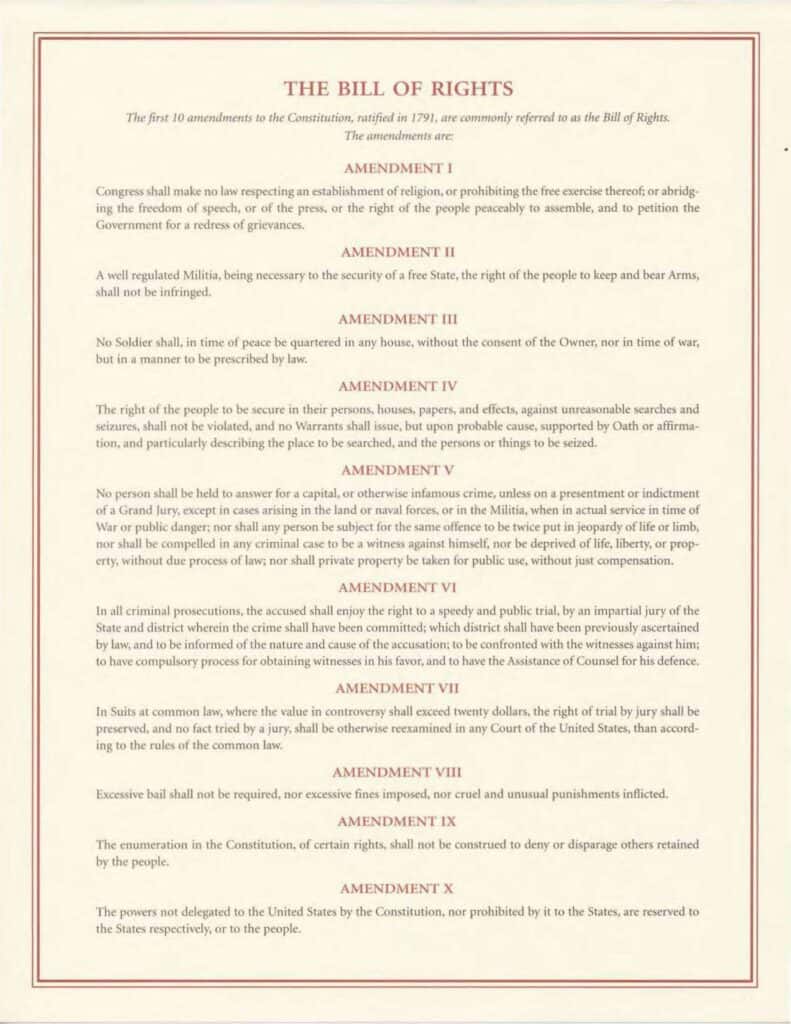About this Lesson
Target Student Group: 10th Grade, Government Class
Lesson Context: This lesson gives students an in-depth look into the rights specifically enumerated by the Bill of Rights and subsequent amendments to the Constitution. In the previous lesson, students were introduced to the Articles of the Constitution, setting the stage for the criticisms put forth by the Anti-Federalists that the people’s rights were not explicitly enumerated in the body of the document. In this lesson, students will examine examples of opposing viewpoints regarding the inclusion of enumerated rights in the Constitution as well as the actual the text of the Bill of Rights.
Primary Source Documents
If the documents are difficult to read on this webpage, please click on the “Source” links to view the docs in their original online locations.
Document 1: Excerpt from the Federalist Papers: “Federalist No. 84, ” Written by Alexander Hamilton in 1788 Source

Guiding Questions for Document 1:
- What is the author’s perspective?
- Is this document reliable?
- Why was this document written?
- What claims does the author make?
Document 2: Excerpt from a Letter to James Madison from Thomas Jefferson, 20 December 1781 Source

- What is this author’s perspective?
- What is the author’s purpose in writing this letter?
- What evidence does the author use to support their claim?
- How does this document agree or disagree with Document 1?
Document 3: The Bill of Rights, Printed Copy Source

Guiding Questions for Document 3:
- Why was this document written?
- How might the circumstances in which the document was created affect its content?
- How does this document express the same or different viewpoints as the previous two documents?
Teacher’s Guide:
Document 1:
- Students should describe the author’s perspective as “federalist” or in support of the ratification of the Constitution without a Bill of Rights.
- Students should state that this document is reliable. Although it was submitted anonymously to a newspaper, students’ background knowledge about Alexander Hamilton and his role both in the Constitutional Convention and later in the US government should inform their decision about the reliability of this source.
- The reason it was written was to rally support for the ratification of the Constitution in response to concerns that it lacks a Bill of Rights. Student responses should include something that addresses the ultimate purpose being to advocate against the inclusion of a Bill of Rights.
- The major claim that students should note is that Hamilton, the author, argues not only that a Bill of Rights is not necessary, but that it would actually be dangerous to include because tyrants might use this to limit citizens’ right to only those enumerated specifically. Other claims about the Constitution’s power being upheld by the people or the existing clarity of rights in the Constitution are also acceptable answers.
Document 2:
- The author’s perspective is that the Constitution must include a Bill of Rights although others have suggested it is not necessary.
- Students’ background knowledge from the previous lesson includes the knowledge that James Madison was the writer of the Constitution. Students should use this fact to inform their answer, which should reflect Jefferson’s desire to convince Madison to add a Bill of Rights to the Constitution.
- Students should include pieces of evidence from Jefferson’s argument such as: the enumeration that all rights not specifically given to the government are given to citizens is not a strong enough claim to protect individual rights, no uniformity amongst the states to guarantee certain rights without a Bill of Rights, people are inherently entitled to a Bill of Rights against any government.
- This document directly disagrees with Document 1 because it strongly states that a Bill of Rights is necessary and beneficial for the people whereas Document 1 says a Bill of Rights is unnecessary and even dangerous for the people.
Document 3:
- This document was written in response to the debate established in Docs 1 and 2. The Bill of Rights was written to appease anti-federalists who would not ratify the Constitution without the specific enumeration of the people’s rights.
- Students might choose to connect specific amendments to their historical context (i.e. Amendment 3 was created due to forced housing of British troops during the Revolution) or students could describe the overall context of the Revolutionary War and Federalist vs. Antifederalist debate.
- Document 3 supports Document 2 because it is the realization of the goals established in Doc 2. Its creation opposes Document 1.


Wow Francesca! Your teachers guide is very detailed and I like your choice of documents. I feel like these are 3 very foundational scriptures in U.S. government that students can be reference back to throughout the year.
Great lesson. Very well designed. An interesting pro-con approach to the Bill of Rights. Especially powerful when we realize divisions of opinion among the framers.
Great scaffolding question and highly detailed teachers guide make it especially impressive.